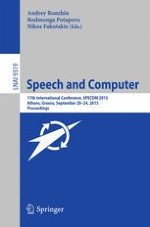This book constitutes the refereed proceedings of the 17th International Conference on Speech and Computer, SPECOM 2015, held in Athens, Greece, in September 2015. The 59 revised full papers presented together with 2 invited talks were carefully reviewed and selected from 104 initial submissions. The papers cover a wide range of topics in the area of computer speech processing such as recognition, synthesis, and understanding and related domains including signal processing, language and text processing, multi-modal speech processing or human-computer interaction.
